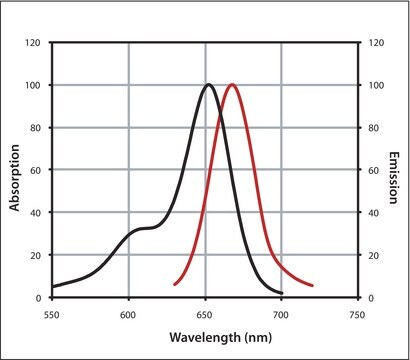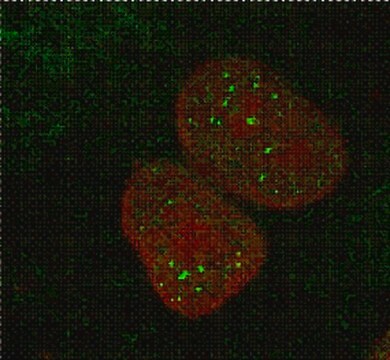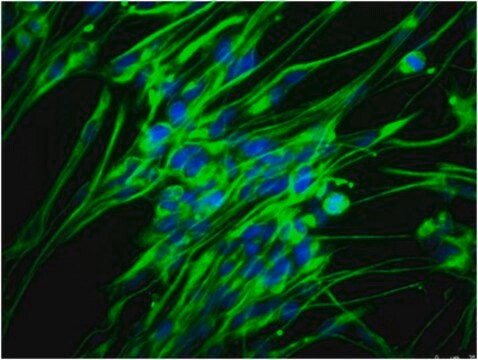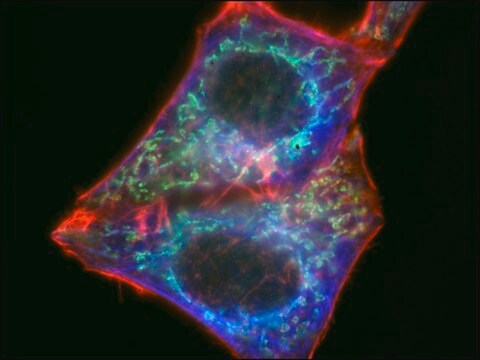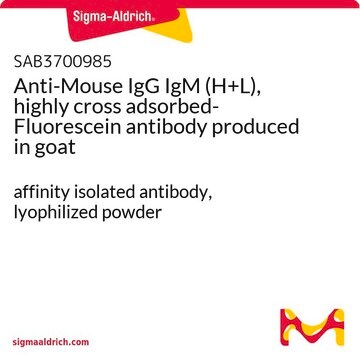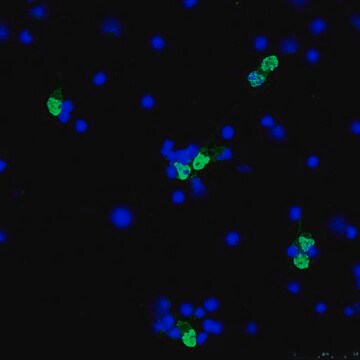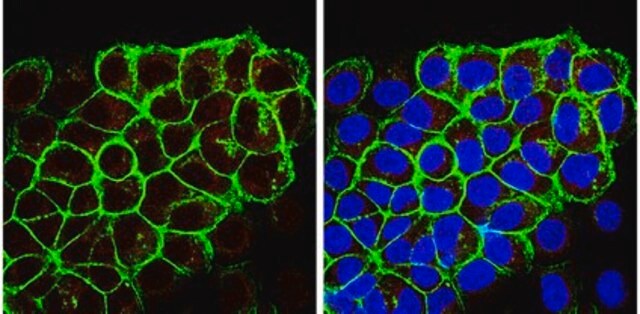おすすめの製品
由来生物
rat
品質水準
結合体
ALEXA FLUOR™ 488
抗体製品の状態
purified antibody
抗体製品タイプ
primary antibodies
クローン
13A4, monoclonal
交差性
mouse
以下との反応禁止
Drosophila, rat, chicken, human
メーカー/製品名
Chemicon®
テクニック
flow cytometry: suitable
入力
sample type epithelial cells
sample type hematopoietic stem cell(s)
sample type: mouse embryonic stem cell(s)
sample type mesenchymal stem cell(s)
sample type neural stem cell(s)
アイソタイプ
IgG1κ
NCBIアクセッション番号
UniProtアクセッション番号
輸送温度
wet ice
ターゲットの翻訳後修飾
unmodified
遺伝子情報
chicken ... Prom1(422825)
human ... PROM1(8842)
mouse ... Prom1(19126)
rat ... Prom1(60357)
詳細
特異性
免疫原
アプリケーション
幹細胞研究
神経幹細胞
造血幹細胞
Note: This antibody does not work with paraffin-embedded sections.
EM immunohistochemistry: The subcellular localization of the 13A4 antigen in mouse E9-10 neuroepithelial cells and adult kidney proximal tubule cells was investigated by immunogold electron microscopy. Strong labeling was observed over the kidney brush border membrane, where 13A4 immunoreactivity appeared to be concentrated toward the tips of the microvilli. Remarkably, in neuroepithelial cells, whose apical plasma membrane contains fewer microvilli than the kidney brush border, 13A4 immunoreactivity was associated mostly, if not exclusively, with microvilli and plasma membrane protrusions, and was not detected in the planar areas of the apical plasma membrane. Because of this preferential localization, the 13A4 antigen was referred to as ′′prominin′′ (from the Latin word ′′prominere,′′ to stand out, to be prominent) (Weigmann et al., 1997).
Western blotting: 1-5 μg/mL in 0.3% Tween in PBS. Sample preparation: Standard Laemmli (boiled in 2% SDS, 100mM DTT or 5% beta-mercaptoethanol, 60mM Tris-HCL pH 6.8). Preferred Gel percentage: 7.5%. Suggested Blocking Buffer: 3-5% Milk, 0.3% Tween in PBS. Incubation time: 1 hour at room temperature or overnight at 4°C. Recommended control extracts: Positive: Kidney membrane; Negative: liver membranes.
Immunoprecipitation: 10-25 μg/mL. Suggested tissue/cell lysis buffer: RIPA bufferFinal reaction volume: 500-1000 μL. Final total protein concentration in reaction mix: 0.5-3 mg/mL. Incubation times: overnight at 4°C. Capture agent used: Protein G Sepharose™ or rabbit anti-rat antibody/protein A Sepharose. Expected sizes on immunoblots (in kDa): 115 kDa (mature form) or 105 kDa (precursor form).
FACS Analysis: Suggested dilution/number of cells: 0.25-1 μg/ million cells. Fixation/Permeabilization used: BD FACS lysis Solution (1-1.5% formaldehyde) (BD and FACS are trademarks of Becton, Dickinson and Company) No permeabilization. Recommended controls: Hematopoietic stem cells.
Optimal working dilutions must be determined by the end user.
物理的形状
保管および安定性
アナリシスノート
Human embryonic stem cell lysate, Caco 2 (Human colonic carcinoma cell line) whole cell lysate
その他情報
法的情報
免責事項
Unless otherwise stated in our catalog or other company documentation accompanying the product(s), our products are intended for research use only and are not to be used for any other purpose, which includes but is not limited to, unauthorized commercial uses, in vitro diagnostic uses, ex vivo or in vivo therapeutic uses or any type of consumption or application to humans or animals.
適切な製品が見つかりませんか。
製品選択ツール.をお試しください
保管分類コード
12 - Non Combustible Liquids
WGK
WGK 2
引火点(°F)
Not applicable
引火点(℃)
Not applicable
適用法令
試験研究用途を考慮した関連法令を主に挙げております。化学物質以外については、一部の情報のみ提供しています。 製品を安全かつ合法的に使用することは、使用者の義務です。最新情報により修正される場合があります。WEBの反映には時間を要することがあるため、適宜SDSをご参照ください。
Jan Code
MAB4310X:
試験成績書(COA)
製品のロット番号・バッチ番号を入力して、試験成績書(COA) を検索できます。ロット番号・バッチ番号は、製品ラベルに「Lot」または「Batch」に続いて記載されています。
ライフサイエンス、有機合成、材料科学、クロマトグラフィー、分析など、あらゆる分野の研究に経験のあるメンバーがおります。.
製品に関するお問い合わせはこちら(テクニカルサービス)
